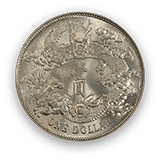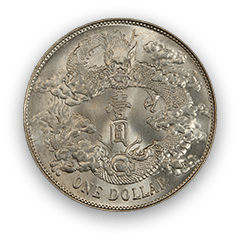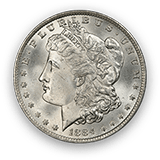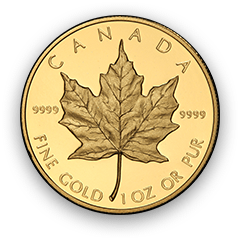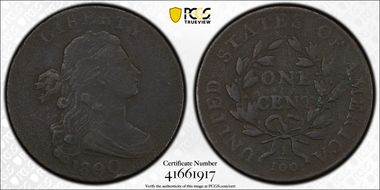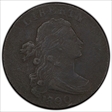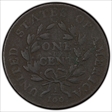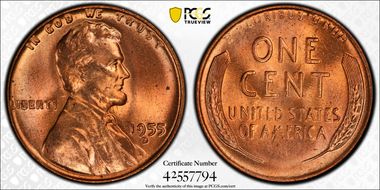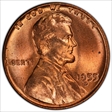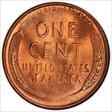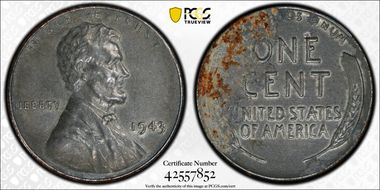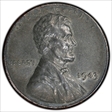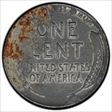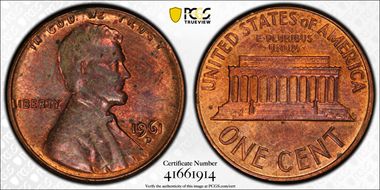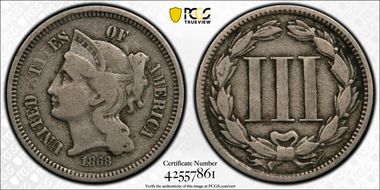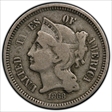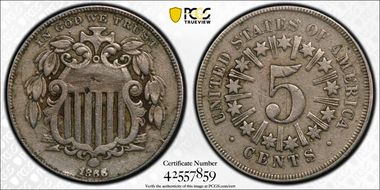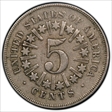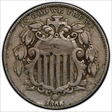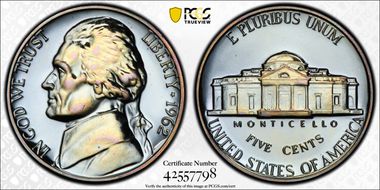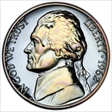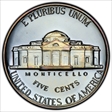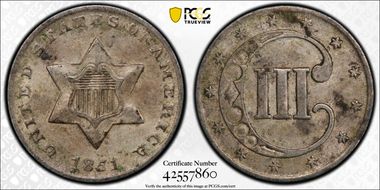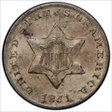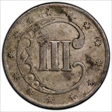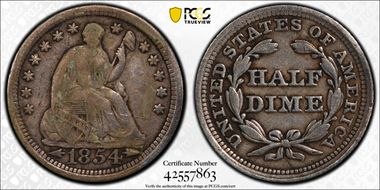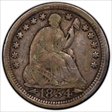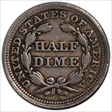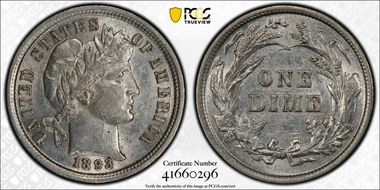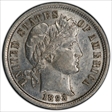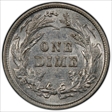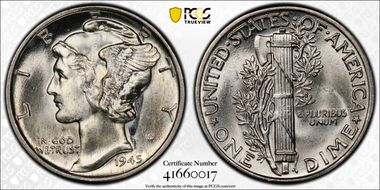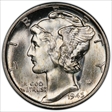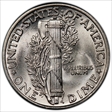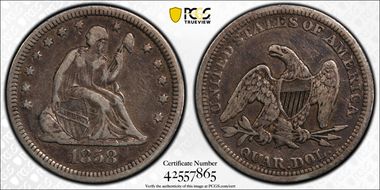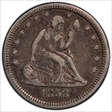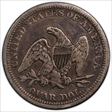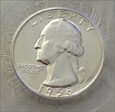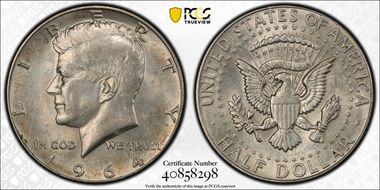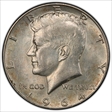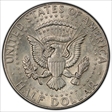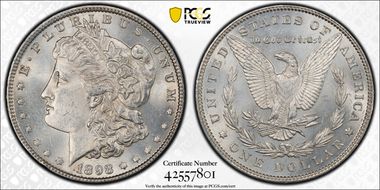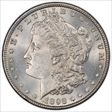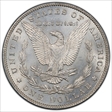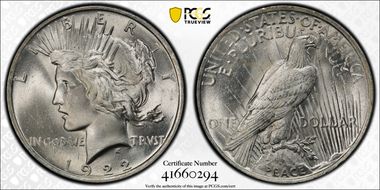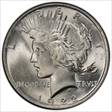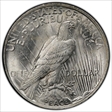CoinCollector2.0 的钱币相册
Coin Collecting: A Passion for Rarity and History Coin collecting, also known as numismatics, is far more than a hobby for many—it’s a pursuit of history, artistry, and rarity. One exceptional acquisition is the 1 Cent 1800/79 United States Draped Bust Large Cent, Variety S-196, a coin that captures both historical significance and numismatic intrigue. Rarity and Uniqueness The 1800/79 overdate variety represents a fascinating chapter in early American minting. This variety occurred when a die originally prepared for 1799 or 1797 was repurposed for striking 1800 cents, showcasing the resourcefulness of the U.S. Mint during its early years. The S-196 designation, part of the Sheldon Large Cent catalog, narrows the coin to a specific die pair, which adds to its numismatic significance. Though not necessarily unique in ownership, coins from this die pair are scarce and highly sought after. Overdates like this are cherished for their historical context, as they reflect the Mint’s challenges in die production and conservation, making such coins a tangible link to the struggles and resourcefulness of America’s formative years. Grading and Condition The N1BN (Mint State “Brown”) grade indicates a near-pristine coin with minimal imperfections and an even brown patina, typical of well-preserved copper coins. The rich toning is a testament to its careful storage and aging process, with natural chemical reactions producing unique hues. Collectors highly value such toning for its visual appeal and contribution to the coin’s individuality. Design Details • Obverse: Features the iconic Draped Bust design by Robert Scot, with Liberty’s profile framed by flowing hair tied with a ribbon. The overdate feature—where remnants of “79” can be discerned beneath “1800”—is a captivating aspect for collectors. Historical Context The 1800 Draped Bust cent emerged during a period of nation-building under President John Adams and later Thomas Jefferson. Copper cents were vital for everyday transactions, and their designs reflected both artistic aspirations and practical considerations. Overdate varieties were a byproduct of the Mint’s frugality, as dies were expensive to produce and repurposed whenever possible. Conclusion The 1 Cent 1800/79 S-196 is more than a collectible; it is a tangible connection to America’s early history, showcasing the ingenuity and artistry of the nascent U.S. Mint. With its rich patina, overdate feature, and historical context, it represents a pinnacle of numismatic achievement, reflecting the dedication of collectors who seek to preserve the past for future generations.
Coin Collecting: A Passion for Rarity and History Coin collecting, also known as numismatics, is far more than a hobby for many—it’s a pursuit of history, artistry, and rarity. One exceptional acquisition is the 1 Cent 1800/79 United States Draped Bust Large Cent, Variety S-196, a coin that captures both historical significance and numismatic intrigue. Rarity and Uniqueness The 1800/79 overdate variety represents a fascinating chapter in early American minting. This variety occurred when a die originally prepared for 1799 or 1797 was repurposed for striking 1800 cents, showcasing the resourcefulness of the U.S. Mint during its early years. The S-196 designation, part of the Sheldon Large Cent catalog, narrows the coin to a specific die pair, which adds to its numismatic significance. Though not necessarily unique in ownership, coins from this die pair are scarce and highly sought after. Overdates like this are cherished for their historical context, as they reflect the Mint’s challenges in die production and conservation, making such coins a tangible link to the struggles and resourcefulness of America’s formative years. Grading and Condition The N1BN (Mint State “Brown”) grade indicates a near-pristine coin with minimal imperfections and an even brown patina, typical of well-preserved copper coins. The rich toning is a testament to its careful storage and aging process, with natural chemical reactions producing unique hues. Collectors highly value such toning for its visual appeal and contribution to the coin’s individuality. Design Details • Obverse: Features the iconic Draped Bust design by Robert Scot, with Liberty’s profile framed by flowing hair tied with a ribbon. The overdate feature—where remnants of “79” can be discerned beneath “1800”—is a captivating aspect for collectors. Historical Context The 1800 Draped Bust cent emerged during a period of nation-building under President John Adams and later Thomas Jefferson. Copper cents were vital for everyday transactions, and their designs reflected both artistic aspirations and practical considerations. Overdate varieties were a byproduct of the Mint’s frugality, as dies were expensive to produce and repurposed whenever possible. Conclusion The 1 Cent 1800/79 S-196 is more than a collectible; it is a tangible connection to America’s early history, showcasing the ingenuity and artistry of the nascent U.S. Mint. With its rich patina, overdate feature, and historical context, it represents a pinnacle of numismatic achievement, reflecting the dedication of collectors who seek to preserve the past for future generations.
Coin Collecting: A Passion for Rarity and History Coin collecting, also known as numismatics, is far more than a hobby for many—it’s a pursuit of history, artistry, and rarity. One exceptional acquisition is the 1 Cent 1800/79 United States Draped Bust Large Cent, Variety S-196, a coin that captures both historical significance and numismatic intrigue. Rarity and Uniqueness The 1800/79 overdate variety represents a fascinating chapter in early American minting. This variety occurred when a die originally prepared for 1799 or 1797 was repurposed for striking 1800 cents, showcasing the resourcefulness of the U.S. Mint during its early years. The S-196 designation, part of the Sheldon Large Cent catalog, narrows the coin to a specific die pair, which adds to its numismatic significance. Though not necessarily unique in ownership, coins from this die pair are scarce and highly sought after. Overdates like this are cherished for their historical context, as they reflect the Mint’s challenges in die production and conservation, making such coins a tangible link to the struggles and resourcefulness of America’s formative years. Grading and Condition The N1BN (Mint State “Brown”) grade indicates a near-pristine coin with minimal imperfections and an even brown patina, typical of well-preserved copper coins. The rich toning is a testament to its careful storage and aging process, with natural chemical reactions producing unique hues. Collectors highly value such toning for its visual appeal and contribution to the coin’s individuality. Design Details • Obverse: Features the iconic Draped Bust design by Robert Scot, with Liberty’s profile framed by flowing hair tied with a ribbon. The overdate feature—where remnants of “79” can be discerned beneath “1800”—is a captivating aspect for collectors. Historical Context The 1800 Draped Bust cent emerged during a period of nation-building under President John Adams and later Thomas Jefferson. Copper cents were vital for everyday transactions, and their designs reflected both artistic aspirations and practical considerations. Overdate varieties were a byproduct of the Mint’s frugality, as dies were expensive to produce and repurposed whenever possible. Conclusion The 1 Cent 1800/79 S-196 is more than a collectible; it is a tangible connection to America’s early history, showcasing the ingenuity and artistry of the nascent U.S. Mint. With its rich patina, overdate feature, and historical context, it represents a pinnacle of numismatic achievement, reflecting the dedication of collectors who seek to preserve the past for future generations.
Look at this beauty, she is so gorgeous! Almost doubling on every single letter on obverse and reverse, upon closer observation you will love the doubling on the date as well, & the rim is telling us another incredible story yet, the toning is out of this world!
Look at this beauty, she is so gorgeous! Almost doubling on every single letter on obverse and reverse, upon closer observation you will love the doubling on the date as well, & the rim is telling us another incredible story yet, the toning is out of this world!
Look at this beauty, she is so gorgeous! Almost doubling on every single letter on obverse and reverse, upon closer observation you will love the doubling on the date as well, & the rim is telling us another incredible story yet, the toning is out of this world!
I am always in a look for rarity, and the unique toning of a coin. This particular Coin was never obtained by any other collector in the history. I may send this back to PCGS for reconsideration, or restoration in order to be designated as a 1893/2 which I know this one is + get upgraded after restoration.
I am always in a look for rarity, and the unique toning of a coin. This particular Coin was never obtained by any other collector in the history. I may send this back to PCGS for reconsideration, or restoration in order to be designated as a 1893/2 which I know this one is + get upgraded after restoration.
I am always in a look for rarity, and the unique toning of a coin. This particular Coin was never obtained by any other collector in the history. I may send this back to PCGS for reconsideration, or restoration in order to be designated as a 1893/2 which I know this one is + get upgraded after restoration.
The 1922 $1 Silver Peace Dollar holds a significant place in U.S. numismatic history. It was minted as part of the Peace Dollar series (1921–1935), designed to commemorate the restoration of peace following World War I. The coin features Lady Liberty on the obverse and a perched bald eagle on the reverse, symbolizing America’s strength and commitment to peace. Why It Was Minted The Peace Dollar was introduced in 1921 as a replacement for the Morgan Dollar, following the Pittman Act of 1918, which mandated the melting of millions of silver dollars and their recoinage. The U.S. Mint initially struck the 1921 Peace Dollar in high relief, but this design caused production difficulties. In 1922, the relief was lowered to extend die life and facilitate mass production, leading to a more practical yet slightly less detailed strike. 1922 Peace Dollar Mintage and Characteristics The 1922 Peace Dollar has the highest mintage of any Silver Dollar—over 84 million coins were struck across the Philadelphia, Denver, and San Francisco Mints. This makes it the most common date in the series. Compared to the 1921 high-relief version, the 1922 design has flatter details, though the strike quality remains decent. Luster on these coins varies, with some displaying a creamy white sheen and others having a hard, chrome-like surface. Grading and Collectability The 1922 Peace Dollar is widely available in Mint State grades, with the majority graded MS63 and MS64 by PCGS. Higher grades (MS65 and above) are more desirable but not particularly rare. Errors and varieties, such as the 1922 “Weak D” or “No D” mintmark varieties, can add extra value to certain specimens. Importance for the Coin Collecting Community 1. Accessibility – Because of its high mintage, the 1922 Peace Dollar is an excellent entry point for collectors wanting to own a historic silver dollar without a high price tag. 2. Historical Significance – As part of the Peace Dollar series, it represents a key period in American history, celebrating the end of World War I. 3. Grading and Investment Potential – While common in lower grades, high-grade examples (MS66+) and prooflike specimens are significantly scarcer, making them desirable for serious collectors. 4. Future Interest – With continued demand for silver coins and historical U.S. coinage, the 1922 Peace Dollar remains a staple in many collections and an important piece for those looking to invest in tangible numismatic assets.
The 1922 $1 Silver Peace Dollar holds a significant place in U.S. numismatic history. It was minted as part of the Peace Dollar series (1921–1935), designed to commemorate the restoration of peace following World War I. The coin features Lady Liberty on the obverse and a perched bald eagle on the reverse, symbolizing America’s strength and commitment to peace. Why It Was Minted The Peace Dollar was introduced in 1921 as a replacement for the Morgan Dollar, following the Pittman Act of 1918, which mandated the melting of millions of silver dollars and their recoinage. The U.S. Mint initially struck the 1921 Peace Dollar in high relief, but this design caused production difficulties. In 1922, the relief was lowered to extend die life and facilitate mass production, leading to a more practical yet slightly less detailed strike. 1922 Peace Dollar Mintage and Characteristics The 1922 Peace Dollar has the highest mintage of any Silver Dollar—over 84 million coins were struck across the Philadelphia, Denver, and San Francisco Mints. This makes it the most common date in the series. Compared to the 1921 high-relief version, the 1922 design has flatter details, though the strike quality remains decent. Luster on these coins varies, with some displaying a creamy white sheen and others having a hard, chrome-like surface. Grading and Collectability The 1922 Peace Dollar is widely available in Mint State grades, with the majority graded MS63 and MS64 by PCGS. Higher grades (MS65 and above) are more desirable but not particularly rare. Errors and varieties, such as the 1922 “Weak D” or “No D” mintmark varieties, can add extra value to certain specimens. Importance for the Coin Collecting Community 1. Accessibility – Because of its high mintage, the 1922 Peace Dollar is an excellent entry point for collectors wanting to own a historic silver dollar without a high price tag. 2. Historical Significance – As part of the Peace Dollar series, it represents a key period in American history, celebrating the end of World War I. 3. Grading and Investment Potential – While common in lower grades, high-grade examples (MS66+) and prooflike specimens are significantly scarcer, making them desirable for serious collectors. 4. Future Interest – With continued demand for silver coins and historical U.S. coinage, the 1922 Peace Dollar remains a staple in many collections and an important piece for those looking to invest in tangible numismatic assets.
The 1922 $1 Silver Peace Dollar holds a significant place in U.S. numismatic history. It was minted as part of the Peace Dollar series (1921–1935), designed to commemorate the restoration of peace following World War I. The coin features Lady Liberty on the obverse and a perched bald eagle on the reverse, symbolizing America’s strength and commitment to peace. Why It Was Minted The Peace Dollar was introduced in 1921 as a replacement for the Morgan Dollar, following the Pittman Act of 1918, which mandated the melting of millions of silver dollars and their recoinage. The U.S. Mint initially struck the 1921 Peace Dollar in high relief, but this design caused production difficulties. In 1922, the relief was lowered to extend die life and facilitate mass production, leading to a more practical yet slightly less detailed strike. 1922 Peace Dollar Mintage and Characteristics The 1922 Peace Dollar has the highest mintage of any Silver Dollar—over 84 million coins were struck across the Philadelphia, Denver, and San Francisco Mints. This makes it the most common date in the series. Compared to the 1921 high-relief version, the 1922 design has flatter details, though the strike quality remains decent. Luster on these coins varies, with some displaying a creamy white sheen and others having a hard, chrome-like surface. Grading and Collectability The 1922 Peace Dollar is widely available in Mint State grades, with the majority graded MS63 and MS64 by PCGS. Higher grades (MS65 and above) are more desirable but not particularly rare. Errors and varieties, such as the 1922 “Weak D” or “No D” mintmark varieties, can add extra value to certain specimens. Importance for the Coin Collecting Community 1. Accessibility – Because of its high mintage, the 1922 Peace Dollar is an excellent entry point for collectors wanting to own a historic silver dollar without a high price tag. 2. Historical Significance – As part of the Peace Dollar series, it represents a key period in American history, celebrating the end of World War I. 3. Grading and Investment Potential – While common in lower grades, high-grade examples (MS66+) and prooflike specimens are significantly scarcer, making them desirable for serious collectors. 4. Future Interest – With continued demand for silver coins and historical U.S. coinage, the 1922 Peace Dollar remains a staple in many collections and an important piece for those looking to invest in tangible numismatic assets.
